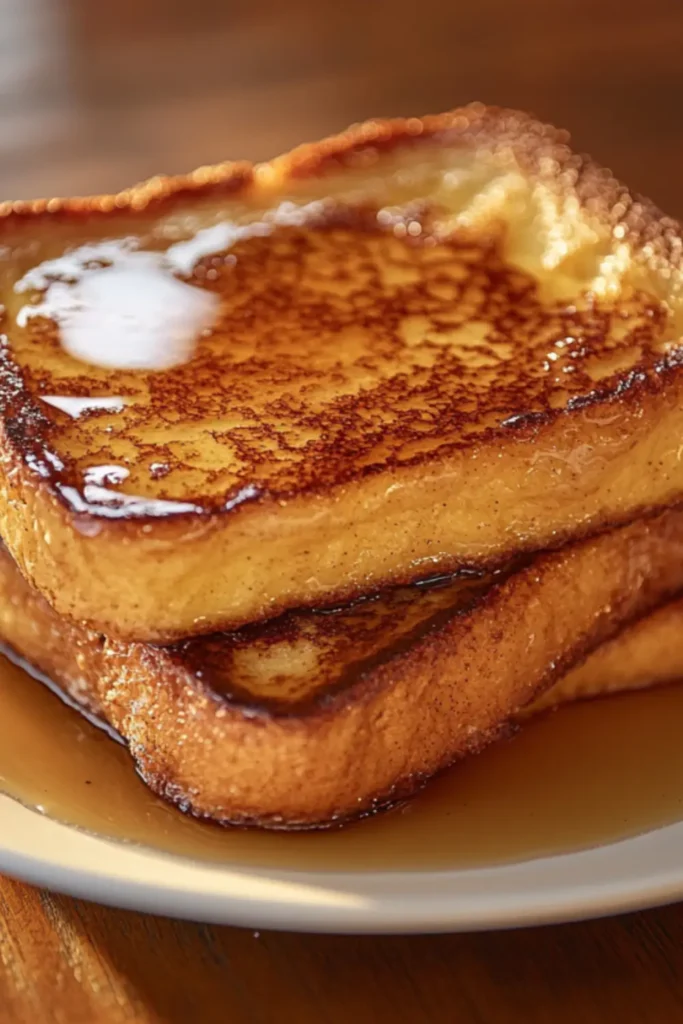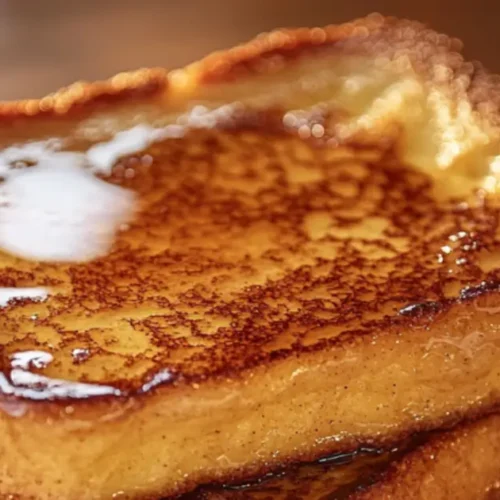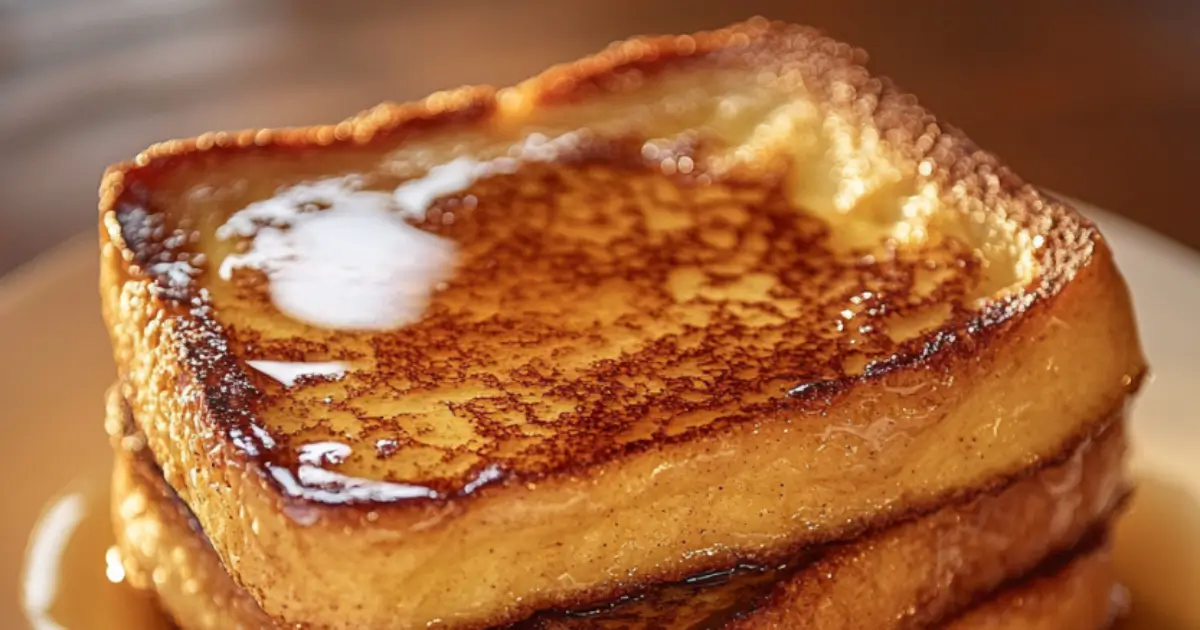If you’re short on time but want something warm and satisfying, this bread toast recipe has you covered. All you need are a few basics like bread, eggs, and milk — or go egg-free with custard powder or corn starch. It comes together fast, tastes like a treat, and works for busy mornings or lazy weekends alike. Cozy, quick, and customizable!
Why We Love This French Toast Recipe
You’re going to love this French toast recipe for so many reasons. First off, it’s fast. You can go from craving to eating in under 10 minutes. That means even on mornings when you’re short on time, a satisfying breakfast is still possible. Second, it’s flexible. Whether you eat eggs or not, you can easily switch the ingredients and still get amazing results.
It also works well with many kinds of bread—white, whole wheat, sourdough, or even day-old slices. This is also a great way to reduce food waste, using up bread that’s slightly dry or not so fresh. With a few pantry staples and a hot pan, you can create a breakfast that feels special without needing anything fancy.
Plus, you can customize it. Add fruits, syrups, spices, or a little extra sugar if you like it sweeter. Every slice is warm, comforting, and golden with that soft center you expect from perfect French toast. You’ll feel like you’re treating yourself—because you are.

Ingredients About French Toast
Making French toast doesn’t take much. Everything you need is likely already in your kitchen. From basic bread and milk to optional add-ins like cinnamon and syrup, this recipe uses simple ingredients to create maximum flavor.
Bread – The most important ingredient in making French Toast. Thick-cut, slightly stale bread works best because it soaks up the egg mixture without falling apart. Avoid fresh, soft sandwich bread—it tends to get soggy and tear easily. Brioche, challah, or Texas toast are ideal choices.
Egg – This helps bind the custard and adds richness to your French Toast. If you’re avoiding eggs, you can substitute with custard powder or corn starch (2 tablespoons per egg) to achieve a similar texture. These egg-free alternatives still produce a deliciously crisp exterior with a soft inside.
Milk – Adds creaminess to the soaking mixture. Whole milk is best, but you can use 2%, oat milk, or any plant-based milk if preferred. If you’re making the egg-free version, increase the milk slightly to maintain the right consistency.
Sugar – Sweetens the custard base just enough. Use granulated sugar or swap with maple syrup, coconut sugar, or brown sugar depending on your flavor preference.
Ground Cinnamon – Adds warmth and classic French Toast flavor. Start with a pinch and adjust to your taste. You can also add a dash of nutmeg or vanilla extract for extra depth.
Butter – Used for cooking, butter gives French Toast its golden crust and rich flavor. Unsalted butter is best, but if using salted butter, reduce or omit the added salt in the custard mixture.
Maple Syrup or Honey – For serving. Classic French Toast is finished with a drizzle of maple syrup or honey. You can also top with powdered sugar, fresh fruit, or a dollop of whipped cream if desired.
How to Make French Toast Directions
Here’s a clear and simple way to make your French toast just right. This recipe walks you through every step so you don’t miss a thing.
Step 1: Prep Your Bread
Start by lightly toasting your bread slices. This helps prevent sogginess. Place them on a pan and toast both sides just until firm—not browned. Using cold or fresh soft bread may result in too much soak and a mushy result, so this little prep step is worth it.
Step 2: Make the Soaking Mixture
Choose a wide bowl—big enough for a slice of bread to dip in easily. Break one egg into the bowl (or add custard powder or corn starch if you’re going egg-free). Pour in the milk, then add sugar, cinnamon, and a pinch of salt. Whisk it all together until it’s smooth and well-mixed.
Step 3: Heat the Pan
Place your pan on medium heat and add about 1 teaspoon of butter for each slice of toast. Let it melt and coat the pan well. The butter not only adds flavor but helps give you that nice crispy edge.
Step 4: Dip and Toast the Bread
Now it’s time to dip your bread. Take one slice and dip it into the mixture, making sure both sides are coated. Let the excess drip off by gently swiping the bread on the edge of the bowl.
Place the soaked slice onto the hot pan. Cook it for a few minutes on one side until the edges start to brown and the egg is set. Then flip and cook the other side. Repeat with the remaining slices.
Step 5: Serve Hot
Once your French toast is done, move it to a serving plate. Drizzle it with maple syrup or honey, and sprinkle a little powdered sugar if you like. Serve hot and enjoy!
How to Serve French Toast
French toast tastes best right after it’s cooked. You can serve it in many ways, depending on what you enjoy or what you have at home. The most classic way is with a light drizzle of maple syrup or honey and maybe a dusting of powdered sugar.
But you don’t have to stop there. Fresh fruits like berries, banana slices, or apple wedges make a great topping. You can also add a dollop of whipped cream or a spoonful of nut butter if you’re feeling a bit fancy. If you like a bit of crunch, toss on some chopped nuts like almonds or walnuts.
French toast also pairs well with warm drinks. Think coffee, tea, or hot cocoa for a comforting combo. Whether it’s breakfast, brunch, or even a late snack, this French toast always fits the moment.
Expert Tips: French Toast
- Use slightly dry bread. Fresh bread can get too soggy when dipped. Day-old slices soak better and hold their shape while cooking.
- Toast before dipping. Lightly toasting the bread before dipping it into the egg mix gives you better texture and avoids a soggy mess.
- Control the heat. Medium heat is ideal. Too high and the outside will burn before the inside cooks. Too low and it may dry out.
- Egg-free tip: If going egg-free, use custard powder or corn starch. You’ll still get a nice coating, and it stays crispy outside and soft inside.
- Butter matters. Don’t skip the butter on the pan—it adds a golden color and rich taste that oil just can’t match.
How to Store French Toast
Sometimes you might have leftovers—or maybe you made a big batch on purpose. French toast stores well and can be easily reheated for a quick meal later.
To store, let the slices cool completely. Place them in an airtight container or wrap them individually with plastic wrap. Keep them in the fridge for up to 3 days.
When you’re ready to eat, reheat the slices on a pan over low heat, in a toaster, or in the oven at 350°F for about 5–10 minutes. This helps bring back the crispy texture. Avoid microwaving if you want to keep the outside from getting rubbery.
Variation of French Toast
French toast is versatile. Once you master the basic recipe, there’s a whole world of variations to try.
- Sweet Banana French Toast: Mash half a ripe banana into the mixture before dipping the bread. It adds natural sweetness and moisture.
- Stuffed French Toast: Add a layer of cream cheese or nut butter between two slices before dipping. Fry as usual for a stuffed version.
- Savory French Toast: Skip the sugar and cinnamon, and instead mix in chopped herbs, salt, and a dash of pepper. Top with sautéed veggies or avocado.
- Vegan French Toast: Use plant-based milk and cornstarch instead of eggs. Coconut or oat milk works great for flavor and texture.
- Fruit-Topped Toast: Add sautéed apples, strawberries, or blueberries on top with a little cinnamon for a fruity finish.
Feel free to get creative. This base recipe can become a dozen different dishes just by changing a few ingredients.
FAQ: French Toast Recipe
Can I make French toast without eggs?
Yes, you can use custard powder or corn starch as a substitute. It still gives a nice coating and tastes great.
What kind of bread is best for French toast?
Thick, slightly stale bread works best. Brioche, sandwich bread, sourdough, or even whole grain slices are all good options.
Why is my French toast soggy?
Too much soaking or using fresh soft bread can cause sogginess. Lightly toasting your bread first helps prevent this.
Can I use non-dairy milk in this recipe?
Yes, almond milk, oat milk, or soy milk all work well and can be used to make it dairy-free or vegan.
Can I freeze French toast?
Absolutely. Let the slices cool, place them in a freezer-safe bag with parchment between each slice, and freeze. Reheat in the oven or toaster when ready.
Is it okay to add toppings before cooking?
Toppings like fruit should be added after cooking. But you can mix flavors like cinnamon, nutmeg, or vanilla into the soak for added taste.

Easy French Toast
Equipment
- Non-stick pan
- Mixing Bowl
- Whisk
Ingredients
Main Ingredients
- 1 large egg or 2 tablespoons custard powder or corn starch for egg-free version
- 4 slices thick bread up to 6 slices; firm or slightly stale bread works best
- 0.25 cup milk or ½ cup if using egg-free version
- 1.5 tablespoons sugar
- 0.125 teaspoon ground cinnamon up to ¼ teaspoon
- 1 pinch salt
- 2 tablespoons butter or more as needed for pan
To Serve
- 2 tablespoons maple syrup or honey or to taste
Instructions
- Prep Your Bread: Lightly toast your bread slices on a pan just until firm to prevent sogginess. Avoid using fresh, soft bread straight from the bag.
- Make the Soaking Mixture: In a wide bowl, whisk together the egg (or custard powder/corn starch), milk, sugar, cinnamon, and salt until smooth.
- Heat the Pan: Place a non-stick pan on medium heat and melt about 1 teaspoon of butter per slice. Make sure the surface is well-coated.
- Dip and Toast the Bread: Dip each slice of bread into the mixture, coat both sides, and let the excess drip off. Cook each slice in the hot pan until golden and cooked through on both sides.
- Serve Hot: Transfer to a plate, drizzle with syrup or honey, and enjoy immediately. Add fruits or powdered sugar if desired.
Send me this recipe!
Just enter your email below and get it sent straight to your inbox!
Notes
- Use slightly stale bread for better texture.
- Toasting before soaking helps avoid sogginess.
- Control heat to cook evenly without burning.
- Custard powder or corn starch creates a great egg-free version.
- Butter adds richness and browning—don’t skip it.


